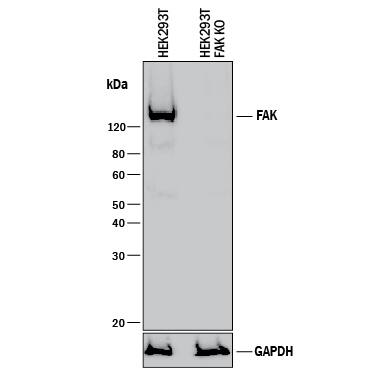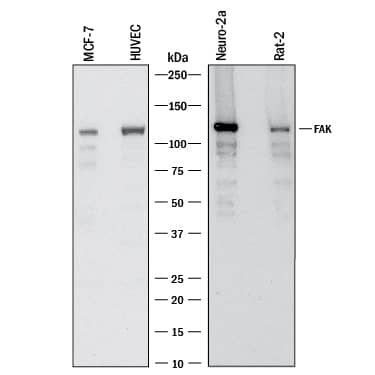Human/Mouse/Rat FAK Antibody
R&D Systems, part of Bio-Techne | Catalog # AF4467

Key Product Details
Validated by
Species Reactivity
Validated:
Cited:
Applications
Validated:
Cited:
Label
Antibody Source
Product Specifications
Immunogen
Asp213-Thr412
Accession # Q05397
Specificity
Clonality
Host
Isotype
Scientific Data Images for Human/Mouse/Rat FAK Antibody
Detection of Human, Mouse, and Rat FAK by Western Blot.
Western blot shows lysates of MCF-7 human breast cancer cell line, HUVEC human umbilical vein endothelial cells, Neuro-2A mouse neuroblastoma cell line, and Rat-2 rat embryonic fibroblast cell line. PVDF membrane was probed with 1 µg/mL of Sheep Anti-Human/Mouse/Rat FAK Antigen Affinity-purified Polyclonal Antibody (Catalog # AF4467) followed by HRP-conjugated Anti-Sheep IgG Secondary Antibody (HAF016). A specific band was detected for FAK at approximately 125 kDa (as indicated). This experiment was conducted under reducing conditions and using Western Blot Buffer Group 1.FAK in Human Brain.
FAK was detected in immersion fixed paraffin-embedded sections of human brain (hippocampus) using 3 µg/mL Human/Mouse/Rat FAK Antigen Affinity-purified Polyclonal Antibody (Catalog # AF4467) overnight at 4 °C. Tissue was stained with the Anti-Sheep HRP-DAB Cell & Tissue Staining Kit (brown; Catalog # CTS019) and counterstained with hematoxylin (blue). View our protocol for Chromogenic IHC Staining of Paraffin-embedded Tissue Sections.Western Blot Shows Human FAK Specificity by Using Knockout Cell Line.
Western blot shows lysates of HEK293T human embryonic kidney parental cell line and FAK knockout HEK293T cell line (KO). PVDF membrane was probed with 1 µg/mL of Sheep Anti-Human/Mouse/Rat FAK Antigen Affinity-purified Polyclonal Antibody (Catalog # AF4467) followed by HRP-conjugated Anti-Sheep IgG Secondary Antibody (Catalog # HAF016). A specific band was detected for FAK at approximately 135 kDa (as indicated) in the parental HEK293T cell line, but is not detectable in knockout HEK293T cell line. GAPDH (Catalog # AF5718) is shown as a loading control. This experiment was conducted under reducing conditions and using Immunoblot Buffer Group 1.Applications for Human/Mouse/Rat FAK Antibody
Immunohistochemistry
Sample: Immersion fixed paraffin-embedded sections of human brain (hippocampus)
Knockout Validated
Western Blot
Sample: HUVEC human umbilical vein endothelial cells, MCF-7 human breast cancer cell line, Neuro-2A mouse neuroblastoma cell line, and Rat-2 rat embryonic fibroblast cell line
Formulation, Preparation, and Storage
Purification
Reconstitution
Formulation
Shipping
Stability & Storage
- 12 months from date of receipt, -20 to -70 °C as supplied.
- 1 month, 2 to 8 °C under sterile conditions after reconstitution.
- 6 months, -20 to -70 °C under sterile conditions after reconstitution.
Background: FAK
Focal adhesion kinase 1 (FAK) is a ubiquitously expressed non-receptor protein tyrosine kinase that is concentrated in the focal adhesions that form between cells growing in the presence of extracellular matrix constituents. This cellular localization is directed by a "Focal Adhesion Targeting" (FAT) sequence, a 125 amino acid sequence at the C-terminus. FAK plays an important role in migration, cell spreading, differentiation, cytoskeleton protein phosphorylation, apoptosis and acceleration of the G1 to S phase transition of the cell cycle. It associates with several different signaling proteins such as Src-family PTKs, p130Cas, Shc, Grb2, PI 3-kinase, and paxillin. This enables FAK to function within a network of integrin-stimulated signaling pathways leading to the activation of targets such as the ERK and JNK/mitogen-activated protein kinase pathways. FAK is also linked to oncogenes at biochemical and functional levels. Increased expression and/or activity of FAK in various tumors has been correlated with enhanced migration and invasiveness of human tumor cells in addition to promoting increased cell proliferation.
Long Name
Alternate Names
Gene Symbol
UniProt
Additional FAK Products
Product Documents for Human/Mouse/Rat FAK Antibody
Product Specific Notices for Human/Mouse/Rat FAK Antibody
For research use only


